Haynes Miller
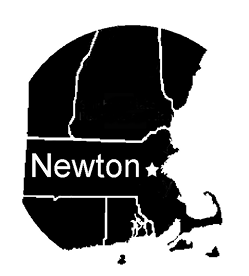 Nahanton Park is a 55-acre mixed-use park owned by the city of Newton.
Nahanton Park is a 55-acre mixed-use park owned by the city of Newton.
Located on the southern edge of the city, it is bounded by the Charles River, the Charles River Country Club, and the Jewish Community Center (JCC). Nahanton Street separates the park from the extensive Cutler Park Reservation wetlands that spread south to Millennium Park in West Roxbury. Nahanton Park is home to the Newton community garden plots, a nature center and kayak rental, and a soccer field. It includes a variety of habitats, from open grassland to riparian woodlands. This combination of location and diverse habitat makes Nahanton Park the most productive birding location in the city of Newton, with more than 180 species recorded to date, including 32 species of wood warblers and 17 sparrow species.
The park has hosted around forty breeding bird species, but for birdwatchers the park is most interesting during spring and fall migrations. The woodland margins attract a wide variety of spring warblers, and the garden plots attract migrant sparrows in the fall that are easy to observe.
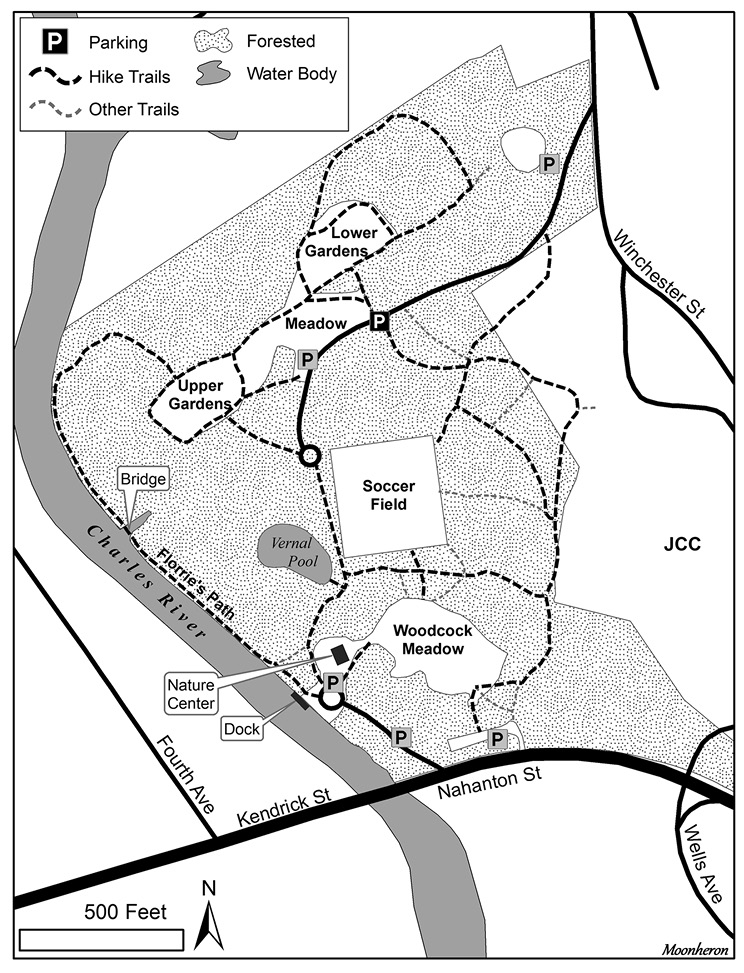
Nahanton Park, Newton, Massachusetts.
From many locations, the convenient way to get to Nahanton Park is via the new Exit 19A off Interstate 95 (I-95) that opened in December 2017. Coming from the north, take Exit 19 (C, B, A) and follow the exit road parallel with the highway toward Exit 19B–Highland Avenue, but continue straight past Exit 19-B for 0.25 mile and take Exit 19A–Kendrick Street. Turn left on Kendrick Street. In 0.5 mile, you will cross the Charles River into Newton, at which point Kendrick Street becomes Nahanton Street. The nature center and kayak rental entrance to the park, 455 Nahanton Street, will be immediately on your left. You can use that parking lot or, to reach the starting point described in this article, continue driving straight past the JCC and Wells Avenue, turn left on Winchester Street, and in approximately 0.3 mile, turn left at the entrance to Nahanton Park, which is 525 Winchester Street. If you pass the golf course, you have gone too far. Note: GPS directions to Nahanton Park will take you to the Nahanton Street entrance; you have to specify the street address for directions to the Winchester Street entrance.
Coming up I-95 from the south, take Exit 19A–Kendrick St., turn right onto Kendrick Street, and continue as above.
Public transportation to Nahanton Park is limited. MBTA Bus 52 runs between the Watertown Yard (inbound) and the Dedham Mall (outbound) on weekdays but does not operate on weekends. You can also catch it outbound at the corner of Beacon and Centre streets close to the Newton Centre T stop on the Green Line D. Bus 52 takes three alternative routes; see https://www.mbta.com/schedules/52/line. The easiest route to access Nahanton Park is via Winchester Street, with a bus stop at Goddard Street (outbound) or Rachel Road (inbound). Walk east along Winchester Street, and the park entrance will be on your right.
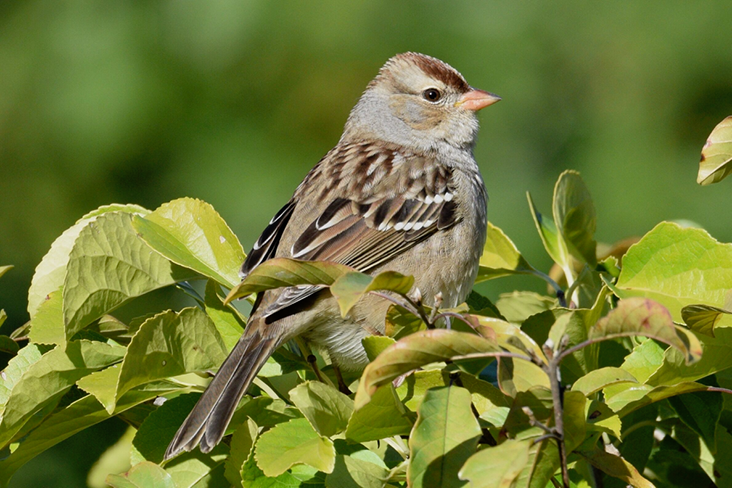
White-crowned Sparrow, Oct 14, 2016. All photographs by the author.
The other two routes are the Charles River Loop and the Dedham Mall route. The stop you want is Parker Street at Dedham Street, which is along the Charles River Loop route. Some of the Dedham Mall buses make this stop and some don't, so read the schedule carefully. From the corner of Parker Street, walk west on Dedham Street, turn south on Rachel Road, and then walk east on Winchester Street. The entrance to the park will be on your right.
This tour of Nahanton Park begins at the parking lot halfway down the entrance road at 525 Winchester Street. Take the short path to the lower garden. Keep an eye on the trees on both sides of this path. The small copse on the left contains nesting American Robins and Gray Catbirds and is a frequent perch for finches, sparrows, and Cedar Waxwings. A Saw-whet Owl was heard there in daylight hours on one occasion. Late season Eastern Towhees often occur here and nearby.
When you come to the lower garden, stop and let the birdlife settle down. The vine-covered patch to the left of the garden plots often hides Carolina Wren and, in season, Wilson's Warbler, Philadelphia Vireo, or other migrants. One year there were many Purple Finches here.
Walk slowly along the pathways between the garden plots. You will flush up Song Sparrows at any season, and White-throated and American Tree sparrows in winter. During fall migration, this is an excellent spot for Lincoln's, White-crowned, Savannah, Field, and Chipping sparrows, as well as Nashville and other migrant warblers. Clay-colored Sparrow, Dickcissel, and Yellow-breasted Chat are almost annual. This is the most likely place in the park to observe Connecticut Warbler. A particularly productive spot is the far right (northernmost) corner of the lower garden plot, where there is a large population of breeding Yellow Warblers and Baltimore Orioles in the area. A Brown Thrasher put in an appearance there in fall 2017. The bird boxes are home to Tree Swallows and House Wrens. You will also find one of the three bat houses installed In Nahanton park in the fall of 2016 with the intention of attracting little brown bats. The breeding success of this species in the park is unknown.
A rough path extends parallel to the entrance road from the east corner of the lower garden. This is the original entrance road to the park—formerly known as Novitiate Park, with reference to the Xaverian Brothers who once owned much of it. This path was redeveloped several years ago by a Boy Scout troop but, sad to say, has not been kept up by the city of Newton. It is still possible to follow it in a large loop, ending up parallel with the golf course and returning to the west corner of the lower garden. This optional detour can bring surprises, such as Hooded Warbler. On Christmas Day 1994, I observed a Say's Phoebe along this path (a sighting distinguished by being one of the first to be rejected by the newly formed Massachusetts Avian Records Committee.
Whether or not you've taken the Boy Scout trail detour, continue now along the dirt road, with the so-called Wildflower Meadow—densely covered by invasive artemesia—on the left and the tall forest on the right. During the spring, these trees hold Chestnut-sided and Black-throated Green warblers, among many other migrants; in summer Red-eyed Vireo and Eastern Kingbird breed there.
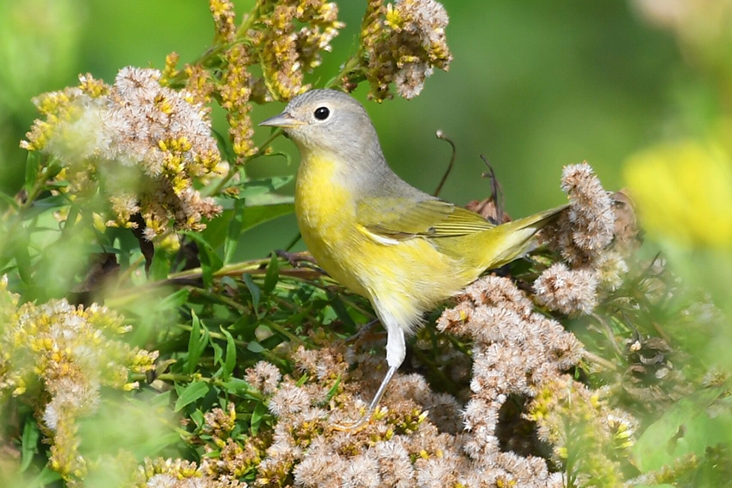
Nashville Warbler, Sept 14, 2017
When you reach the upper garden, walk through its pathways. This is another excellent sparrow trap in the fall, when Indigo Bunting and Common Yellowthroat are also common. The woods contain breeding Ruby-throated Hummingbird and Rose-breasted Grosbeak. Yellow-throated Vireo has been known to spend the summer nearby. Golden-winged Warbler and White-eyed Vireo have been observed here in recent years. A wide variety of fall migrant warblers, including Hooded, Tennessee, and Orange-crowned, use the margins of this garden area. The screen of trees at the far (southwest) end of the upper gardens warms up early and attracts a good selection of birds at any time of year, including Blue-gray Gnatcatcher and Great Crested Flycatcher in the fall. Blue Grosbeak has been observed here several times. Northern Bobwhite was dependable in Nahanton Park in the mid 1990s; a stray put in an appearance in 2014. Eastern Bluebird used to breed regularly in the park's nest boxes but has appeared only occasionally since 2011.
You now have a choice of how to reach the Charles River. A rough and briefly steep path leads past the beehives and into the woods from the northwest corner of the upper garden. Barred Owl has been observed here. This trail borders on a wet, wooded area adjacent to the golf course. The path leads down to the river, then left along a rough trail to a simple bridge providing a connection to the end of Florrie's Path, a wheelchair accessible pathway that extends along the river to the parking area for the Nature Center. Prothonotary Warbler has been observed here in May 2005 and May 2014.
The other option from the upper garden to the Charles River is easier. Go back to the entrance road, either by following a short path through the woods or another path along the wood margin; both start at the east corner of the upper garden. Walk to the circle at the end of the roadway. The soccer field is in front of you. There's a small depression to the left that sometimes holds Northern Waterthrush or sparrows. You can walk along the margin of the soccer field, leaving it to your left, or along a path cut parallel to that edge of the field. The sun warms the tree margin, bringing in interesting birds, such as Brewster's Warbler and Yellow-breasted Chat.
The pathway is heavily sheltered and can offer close views in any season—Hermit Thrush, Common Yellowthroat, American Redstart (an occasional breeder), and Great Crested Flycatcher, among others. A small pool (home to spotted salamanders) lies to your right. There is a view into it from the trail, and after the path curves to the right at the end of the field, a set of concrete steps leads down to the edge. If there is water in the pool, you will find Mallards and Wood Ducks and, in the fall, Solitary Sandpipers or herons. In winter, this is a gathering spot for American Tree Sparrows. Springtime brings warblers—Black-and-white, Black-throated Blue, Black-throated Green, Yellow-rumped, Common Yellowthroat, and American Redstart—over the pond, and Blue-headed Vireo in the trees. One year, a Wood Thrush nested close over the trail here, and Yellow-throated Warbler has been recorded in this area.
Continuing along the trail, you'll come out to the Charles River. Charles River Canoe and Kayak has an active rental center here in the summer. Turning right at the river takes you along Florrie's Path; this can be good for migrating fall warblers, such as Blue-winged. Common Yellowthroat, Warbling Vireo, and Blue-gray Gnatcatcher breed along the river, and in 2018 Black-billed Cuckoo nested here. In May 2017, a Gray-cheeked Thrush was observed by many on Florrie's Path and in the parking circle in front of the Nature Center.
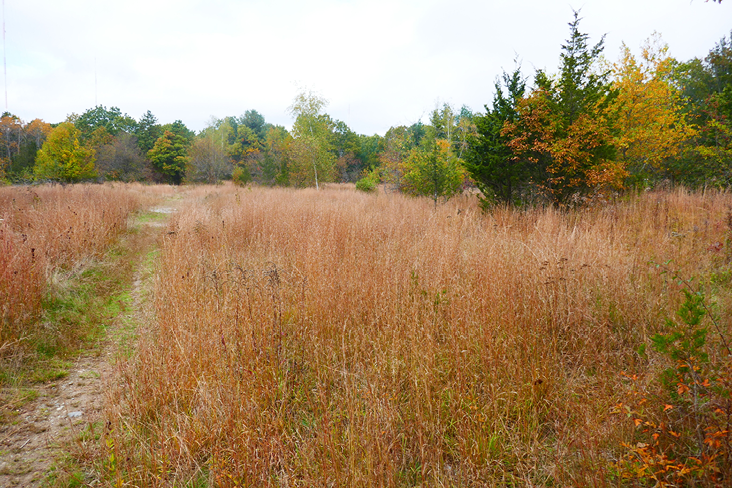
Woodcock Field, Oct 23, 2017.
Walk out onto the boat dock. Upriver to the left, Barn Swallows breed under the Nahanton Street bridge. Tree and Northern Rough-winged swallows frequently hawk insects over the water. Scan the treetops on the other side of the river for Eastern Kingbirds. Spotted Sandpipers work the riverbank in the fall, and Northern Waterthrush in the spring. There are occasional Hooded Mergansers on the river in the fall, and sometimes a congregation of Green Herons.
Turn around and walk up the rise past the Nature Center. An Eastern Phoebe has traditionally nested in the eaves of this building. Attend to the trees in back of it and beyond; this is a good spot for Ruby-crowned Kinglet in early spring. You can find sparrows in the leaf litter near the path.
Walk along the grassland paths. This is known as Woodcock Meadow because of the dependable Woodcock display in February and March. One concludes that these birds breed in the neighboring woods, and they have been seen from time to time in summer. The best way to observe them is to park at the (south) end of Woodcock Meadow, in a lot with a separate access off of Nahanton Street. You can walk out onto the field and have the sunset in front of you, making the Woodcocks easier to see. They start their display fifteen minutes after sunset on calm early spring evenings.
This field had become overgrown with white pine and other successional plants but has been restored by a joint effort of the city of Newton and volunteers. (The area had been rendered grassland in the 1950s as a Nike missile decoy site.) The bluestem grass is beautiful in the fall.
This is also an excellent place to find dragonflies. Walk through it via any of the narrow paths. The occasional trees often hold surprises—Least Flycatcher, Black-billed Cuckoo, or Golden-crowned Kinglet in fall, for example. If you walk along the southwest edge of the field in fall or early winter, inspect the forest floor to your right carefully for Eastern Towhees and White-throated and Fox sparrows. They often gather here and under the scrubby trees at the end of the field, adjacent to the parking lot. In spring, look for Magnolia or Blue-winged warblers.
Now you can return to the soccer field, walk along its eastern edge, and take a shortcut through the woods back to the parking lot. Or if you want to bird for a while longer, pick up the trail into the woods at the southeast corner of Woodcock Meadow. This trail leads through upland forest. Occasionally in early fall the forest floor fills with a huge flock of Common Grackles. I counted 740 one year. Downy, Red-bellied, and occasionally Hairy woodpeckers are found here. In summer, be alert for breeding Eastern Wood Pewee, Red-eyed Vireo, and Great Crested Flycatcher. The trail leads up to the highest point in the park, with the JCC visible to your right. Here you may find Yellow-bellied Sapsucker, Wild Turkey, or other woodland species. In October 2018 a Barred Owl put in an appearance here. A brief detour to the red pine plantation at the JCC will produce breeding Pine Warblers and Chipping Sparrows in season.
The path leads back to the parking lot where we started. Other short trails lead off to the right through woodland that is always worth exploring. You can check out the newly planted lawn across the entrance road near Winchester Street for Dark-eyed Juncos and allies in fall and winter. In spring 2017, a Worm-eating Warbler held forth from the woods below this lawn for a week or so. Finally, turn down the roadway and recheck the parking lot.
Nahanton Park is a valued Newton resource, watched over by the Friends of Nahanton Park: http://www.nahantonpark.org. It is ungated and open from dawn to dusk all year long.
Acknowledgements: Thanks to Suzette Barbier, Chris Hepburn, and Ian Reid for comments on this account.
Haynes Miller, mathematician by trade, has been birding the Newton area since 1986. His passion was stoked by a bird walk in Cutler Park, Needham, led by the late Elisha Atkins. A Yellow-throated Vireo put in an appearance, and no one could fail to appreciate the combination of the leader's instant recognition, his excitement at the discovery, and the sheer beauty of the bird. A believer in the dictum that anything can show up in one place if you wait long enough, Miller has recorded 183 species to date at Nahanton Park. But he also engages in international birding, traveling recently to Ecuador, Brazil, Colombia, China, and Kenya.